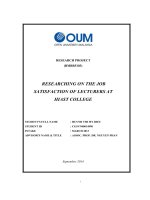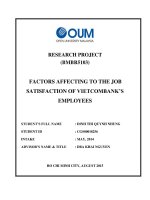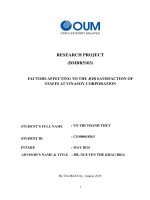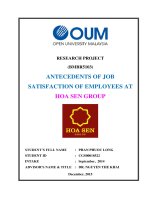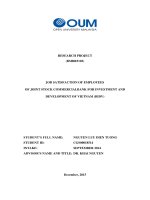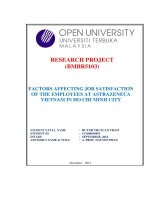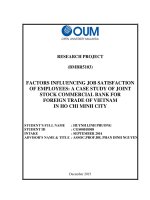Job satisfaction of employees at Sales Department of Garment 10 Corporation, JSC
Bạn đang xem bản rút gọn của tài liệu. Xem và tải ngay bản đầy đủ của tài liệu tại đây (417.74 KB, 87 trang )
NATIONAL ECONOMICS UNIVERSITY
BUSINESS SCHOOL
BUI PHUONG THAO
JOB SATISFACTION OF EMPLOYEES
AT SALES DEPARTMENT OF GARMENT 10
CORPORATION, JSC
MASTER OF BUSINESS DMINISTRATION THESIS
HANOI – 2021
NATIONAL ECONOMICS UNIVERSITY
BUSINESS SCHOOL
BUI PHUONG THAO
JOB SATISFACTION OF EMPLOYEES
AT SALES DEPARTMENT OF GARMENT 10
CORPORATION, JSC
MASTER OF BUSINESS DMINISTRATION THESIS
SUPERVISOR:
DR. NGUYEN QUOC DUY
HANOI – 2021
ACKNOWLEDGEMENTS
I would like to express my special thanks to my supervisor Dr. Nguyen Quoc
Duy for his guidance and immense knowledge that contributed to my study and
helped me a lot in all the time of my study and writing this thesis.
My gratitude to Sales department, Administration, Planning department of
Garment 10 Corporation - Joint Stock Company for allowing me to approach the
respondents and providing me the information needed for the thesis.
I would like to acknowledge the Business School for their continuous supports
and instructions during my time in this MBA program.
Last but not least, I am extremely grateful to family who are always giving me
encouragements, supports and advices throughout my life.
TABLE OF CONTENTS
STATUTORY DECLARATION
I herewith formally declare that myself have written the submitted Master’s
Thesis independently. I did not use any outside support except for the quoted
literature and other sources mentioned at the end of this paper.
Hanoi,
/
/2021
ABRREVIATIONS
BOM
CMT
EU
FOB
Garco10
ISO
JSC
KPI
OBM
ODM
PO
SOP
TNA
UCP
VINATEX
VND
Balance sheet of material
Cut- Make- Trim
Europe
Free on board
Garment 10 Corporation
International organization for standardization
Joint Stock Company
Key performance indicator
Original brand manufacturer
Original design manufacturer
Purchasing order
Standard operating procedure
Time and Action Plan
Uniform customs and practice for documentary credits
Vietnam National Textile and Garment Group
Vietnam Dong
LIST OF FIGURES
Figure 1.1 Research process......................................................................................14
Figure 2.1 Research Model........................................................................................26
Figure 3.1: Garco10 organization structure................................................................36
Figure 3.1: Garco10 revenue at 5 year period (unit: billion VND)............................38
Figure 3.2 Garco 10’s annual revenue growth rate in five year period (%)................39
Figure 3.3: Garco10’s earning before tax of in recent years (unit: billion VND).......39
Figure 3.4: Garco 10 monthly average income of employee in recent years (unit:
million VND)...........................................................................................39
Figure 3.5: Garco10’s export market proportion........................................................42
Figure 3.6: Age group of Garment 10 Sales department (years old)..........................45
Figure 3.7: Gender proportion of employees at Garco10 Sales department...............46
Figure 3.8: Education level proportion of employees at Garco10 Sales department..46
Figure 3.9: Year of experience of employee in Garco10 sales department.................46
Figure 3.10: Distance from home to workplace of employee in Garco10 sales department...47
Figure 3.11: Expectation and satisfaction with the nature of job in Garco10
Sales department....................................................................................48
Figure 3.12: Expectation and satisfaction with recognition, appreciation and reward, job
objectives and KPI setting of Sales staff in Garco10 Sales department..........48
Figure 3.13: Expectation and satisfaction with the Advancement and Growth in
Garco10 Sales department........................................................................50
Figure 3.14: Expectation and satisfaction with Supervision in Garco10 Sales department. .51
Figure 3.15: Expectation and satisfaction with Salary in Garco10 Sales department 52
Figure 3.16: Expectation and satisfaction with Interpersonal and Company policy and
procedure in Garco10 Sales department...................................................54
Figure 3.17: Expectation and satisfaction with physical working condition,
equipment, materials and software system in Garco10 Sales department.55
Figure 3.18: Expectation and satisfaction with Job security in Garco10 Sales department. .57
Figure 3.19: Overall expectation of employee in Garco10 Sales department............57
Figure 3.20: Overall satisfaction of employee in Garco10 Sales department.............57
Figure 3.21: Overall gap between expectation and satisfaction of employee in
Garco10 Sales department........................................................................58
LIST OF TABLES
Table 1.1: Sales department’s turnover rate...............................................................12
Table 2.1: Variables and items of thesis research model............................................27
Table 3.1: Business results of Garco 10 in recent years.............................................38
Table 3.2 Garco10 export quantity proportion by product in 2019............................40
Table 3.3: Garco10 export revenue proportion by product in 2020............................40
Table 3.4: Garco10 revenue proportion.....................................................................41
Table 3.5: Garco10 number of export countries.........................................................41
Table 3.6: Sales Department human resource status..................................................45
9
EXECUTIVE SUMMARY
Being a factory founded in 1946, after more than 70 years of development,
Garment 10 Corporation nowadays is one of the largest company in Vietnam
garment industry. Each year, the FOB order which is taken care by Sales department
counts for 75% of the company revenue and staff of this department, whose job is
merchandiser, has major role in ensuring the FOB order and customer requirements
are implied correctly and timely in actuality. A merchandiser should have
experience from 3 to 5 years to meet the job requirements and manage the FOB
order well. However, the turnover rate of the department in 2016 to 2020 increased
from 2% to 10%, and other symptoms of dissatisfaction are founded such as
procrastination, boredom and irritability. So the research namely “Job satisfaction of
employees at Sales Department of Garment 10 Corporation, JSC” is made to
evaluate the degree to which the employees of Sales department are satisfied with
their jobs, what is satisfied and what is not.
Particularly, the objectives of the thesis are to identify the determinants of
job satisfaction of employees in this department, to assess job satisfaction level and
find out the root cause of satisfaction or dissatisfaction of Garco10’s staff of sales
department, therefore proposing recommendations to improve their job satisfaction.
To conduct the research, all staff of the department were asked for their
expectation and satisfaction towards 8 dimensions of satisfaction, so both primary
data (from questionnaire, interview) and secondary data (including company report,
newspaper,…) are collected, in quantitative, qualitative form. In questionnaire, both
closed ended questions in Likert scale, and open ended questions are raised, also
observation, face to face questionnaires and online questionnaires are used. The data
collected are then analyzed in descriptive statistics in table and graphical form.
The research shows that within eight dimensions of job satisfaction, the work
itself, the amicable and supportive interpersonal relations, safe and convenient
working conditions, job security, and supervision are factors that satisfy the staff.
10
On the other hand, the working condition (company software), recognition (KPI and
performance appraisal process), salary scheme, interpersonal relations (working
SOP), advancement and growth factors still have outstanding shortcomings and
needs improvement and more attention from management.
To
enhance
the
job
satisfaction,
the
thesis
contributes
several
recommendations including: (1) for working condition, particularly company software
in terms of user manuals and rules in creating item code, BOM, PO, material
allocation, order closing should be complied strictly; (2) in recognition, KPI and goals
setting in both work output and managerial competences,
people involved in
performance appraisal, job rank should be reviewed and revised; (3) pay level,
distribution and salary increase scheme should be taken into account to be more
competitive, and have a clearer commitment to staff; (4) for interpersonal relations,
working SOP should have more innovation to foresee and solve the job conflict; (5)
advancement and growth should be stick with the job rank and job requirement, and
give more chances for staff to develop themselves in both working and managerial
competences.
11
CHAPTER 1
INTRODUCTION
1.1
Rationale of the study
Garment 10 Corporation (Garco10) is well known as one of the largest and
leading enterprises in Vietnam garment industry. In the coming years, Vietnam
garment industry is expected to benefit from many Free Trade Agreement, but also
faces fiercer competition and unfavorable factors. So firms want to survive and
thrive, they need to be lean, effective and responsive to both opportunities and
threats, and human resources quality and stability are crucial to achieve that goal.
The higher the employee satisfaction level with their job, the better they perform
and the higher the productivity also. Thus, in order to sustainably develop and
execute firm’s strategy, employee satisfaction is a determinant to be reviewed.
In Garment 10 Corporation, Sales Department is responsible for taking care of
Free On Board orders which counts for around 75% of Garco10’s revenue. FOB order
and its revenue takes the vital proportion in revenue and ensures job for thousands of
Garco10’s workers. Staff of sales department is called “merchandiser” whose job is the
bridge to connect customers and factories. They follow several steps including
researching market; garment costing; sourcing and purchasing materials, negotiating
material price; supervising time and action plan to ensure the materials availability,
arranging production schedule, and other related issues for example quality claims;
inspection … etc.
With that combined role of sale- purchasing- planning, a merchandiser is
required to have 3 to 5 years of experience to completely deal with the job
requirement, and a small flaw during their job can lead to company’s huge
damage/waste for example air freight for material/ garment, bulk rejection, bulk
repair, excess or shortage of material, penalty on price and so on. Furthermore, a
skillful and experienced merchandiser can help gain more money by making the
optimal costing to each garment style and targeted customers; can foresee the
possible problems with each material to have solutions suggested to customers or
12
other department to avoid waste and increase the job efficiency; can cut the cost by
negotiating the material price from supplier by understanding their product’s pros and
cons. As the merchandiser job involves many aspects of production, every task a
merchandiser does with high efficiency can gain and save a lot of money for the firm.
For example, in 2019, a team of 5 staff in the Sales Department effectively saved
roughly 940 million Vietnam Dong by utilizing the redundant materials to export
more quantity within the accepted tolerance of their customer, and negotiating the
claim with suppliers.
However, the employees turnover rate of the department during 2016 to 2020 is
increasingly from 2% to 10%. In the first quarter of 2020, 8 employees left the
department, some of them has worked for 4 to 7 years at the department. Some other
symptoms are present in the department such as procrastination, irritability and
boredom.
Table 1.1: Sales department’s turnover rate
Number of employee
left the department
Average number of
employee
Turnover rate
Unit
2016
2017
2018
2019
2020
People
2
1
3
7
8
People
45
48
55
65
66
Percentage (%)
4.44
2.08
5.45
10.77
12.12
Source: Company internal annual report
When the employees left the department, this issue costs the company not
only training cost, but also the possible undesirable waste from new employees
during their new job with lack of experience. So in this study named “Job
satisfaction of employees at Sales Department of Garment 10 Corporation,
JSC”, we will evaluate the degree to which the employees of Sales department are
satisfied with their jobs, what is satisfied and what is not.
1.2
Research objectives and research questions
By identifying and analyzing the determinants of job satisfaction to Sales
Staff of the company, the primary purposes of this study are to:
- Identify the factors impact job satisfaction of staff in Garco10 Sales department
13
- Assess job satisfaction level and find out the root cause of satisfaction and
dissatisfaction of Garco10’s staff of sales department.
- Propose recommendations to improve their job satisfaction.
The thesis aims to give answer to three questions as following:
1. What factors affect employee satisfaction at Sales Department of Garco10?
2. How well Garco10 Sales Department employees satisfy with their job and its root
causes?
3. How can Garco10 increase their employee job satisfaction?
1.3
Research methodology
1.3.1 Research process
Applying Hussey and Hussey research process model, the research process
of the topic “Job satisfaction of employees in Sales Department of Garment 10
Corporation, JSC” is categorized into 5 phases below, and steps named determine
research objectives was mentioned in previous parts.
Secondly, to select the theoretical framework, the determinants of job
satisfaction in previous published research in several industries and several
countries were listed out, then among that factors, 8 factors are select for the
research model.
Other steps which are data collection, data analysis and propose
recommendation will be clarified in following sections.
Determine research objectives
Select theoretical framework
Collect data
Analyze employee satisfaction level
Propose recommendations
14
Figure 1.1 Research process
Source: Author
1.3.2 Data collection
1.3.2.1 Sampling
The satisfaction degree is researched in December 2020, with the sample of
66 current employees of Sales Department in Garco10 head office in Sai Dong
Ward, Long Bien District, Hanoi, and 01 sale manager to see their constrain/
problem in satisfying the employee.
1.3.2.2
Data collection
In terms of data sources, both primary data (from the questionnaire,
interview with employees) and secondary data (company report, newspaper, book,
etc) are studied. Both quantitative and qualitative data are collected to get the
figures for easy comparison, also the opinions of employees/manager for a deep
reflection and understanding the satisfaction level.
Therefore, the closed-ended questions and open ended- questions are used
in the questionnaire to have quantitative and qualitative data. In quantitative
data, ordinal scale/Likert scale is used when employees rate their level of
satisfaction from 1 (strongly dissatisfied) to 5 (strongly satisfied). Also,
observation, face to face questionnaires and online questionnaires (Google
form) are used to obtain the data.
1.3.2.3
Research scope
This study analyses the employee satisfaction at Sales department of
Garco10;
Study scope: the research is conducted at Sales department, in Garco10 head
office, Sai Dong Ward, Long Bien District, Hanoi.
Data collection duration: primary data is collected in December 2020 and the
secondary data is from 2016 to 2020.
1.3.3 Data analysis
The data from questionnaire are then analyzed to the descriptive statistic
by Microsoft Excel to summarize and show the quantitative data. Tables,
graphical forms (bar chart, pie chart), mode, mean are used to indicate the
characteristics of data.
15
1.4 Research structure
This research is structured as following:
Chapter 1: Introduction
Chapter 2: Theoretical background on employee job satisfaction.
Chapter 3: Study results on job satisfaction of employees in sales department
of Garment 10 Corporation, JSC
Chapter 4: Recommendations to enhance job satisfaction of Garco10 Sales
department employees
16
CHAPTER 2
THEORETICAL BACKGROUND ON JOB SATISFACTION
2.1
Definition of job satisfaction
According to Nancy C. Morse (1997) “Satisfaction refers to the level of
fulfillment of one’s needs, wants and desire. Satisfaction depends basically upon
what an individual wants from the world, and what he gets”.
Regarding the job satisfaction, there are several definitions about this term
by many authors around the world through time.
In 1935, Hoppock, the pioneer author, described job satisfaction as any
combination of psychological, physiological and environmental circumstances that
cause a person truthfully to says “I am satisfied with my job”. So by this approach,
job satisfaction is the result of several external determinants and it also refers to the
internal factors describing how the employee feels. Vroom in 1964, in his research
on job satisfaction emphasized the employee’s role in the workplace, to define the
job satisfaction as affective orientations on the part of individuals toward work roles
which they are presently occupying. In 1985, Davis et al., defined job satisfaction
represents the extent to which expectations are and match the real awards and it is
closely linked to that individual's behavior in the work place. According to Aziri in
2008, job satisfaction is defined as a feeling that appears as a result of the
perception that the job enables the material and psychological needs.
2.2
Importance of employee job satisfaction
With regards to the importance of job satisfaction, obviously, employee job
satisfaction is one of the major factors to create the human resources stability and
loyalty. Several authors studied the relationship and importance of employee
satisfaction to other aspects of the company as following:
Judge, et. al, (1993), indicated that employee satisfaction is in positive
correlation with job performance, job involvement, job motivation, life satisfaction,
mental health, organizational citizenship behavior, organizational commitment, and
17
in negative relation to turnover, absenteeism and perceived stress. In Heskett et al
‘s research in 1994, the more satisfied employees are, the more stimulated a chain
of positive actions will be, and in the end, improving firm’s performance. Also,
according to Thrun, 2014, job satisfaction is one of the most important factors
driving to get optimal work results. When an employee feels satisfied with their
work, he will try with all the skills he has in order to complete his job tasks.
Another study showed that firms who are superior in employee satisfaction
matter, can lower the turnover rate by 50%, gain customer satisfaction around 95%
more and decrease labor cost by 12%., Carpitella, (2003). Besides, Harter et al.
(2002), based on 7,939 business units in 36 organizations, they emphasized positive
and substantive correlations between employee satisfaction-engagement and the
business unit outcomes of profit, productivity, employee turnover, employee
accidents, and also customer satisfaction.
2.3
Determinants of employee satisfaction
According to Frederick Herzberg (1959), one of a well- known
motivational theorists, in an interview with about 200 American accountants
and engineers, he classified two groups of factors that result in satisfaction
namely: motivators and hygiene.
Motivators are factors that directly and critically motivate people to work
harder, yield employees satisfaction intrinsically by fulfilling employee’s needs for
their perceived value and personal growth, about whether what employees do are
significant. So belong to this group, there are factors namely: achievement,
recognition, work itself, responsibility, advancement and growth. If the need for
above factors are met, employees are satisfied with their job and have better
performance at work.
On the other hand, according to Herzberg, hygiene are factors from
organization environment, how employees are treated at work and helps prevent the
dissatisfaction, however, these factors alone can not create fully motivation and
satisfaction to employees. By the way of explanation, employee will be dissatisfied
18
if hygiene factors are lacking or mishandled. Hygiene factors include company
policy and administration, supervision, interpersonal relations, working
conditions and salary. So Herzberg’s idea is that besides the motivation factors,
firms should ensure they pay employees properly and the working conditions are
adequate. Motivators will not effect if hygiene factors are not present. Now we will
look into details of each factors belong to these two groups.
2.3.1Achievement
Herzberg‘s (1966) and Herzberg et al. (1959) defined the sense of
achievement is created when employees are able to complete their task, provide
solutions to the conflicts and problems, prove their capability, or observe the
outcome of their hard work. A job should give employee a certain sense of
achievement and accomplishment. This will provide them a proud feeling when
their job is difficult but worthwhile, they could use their talents. So setting SMART
objectives, reasonable and fair KPI for each job, also ensure employees know what
those goals and requirement are can help employees gain this sense of achievement.
2.3.2Recognition
Herzberg (1966) and Herzberg et al. (1959) defined recognition as an
execution of notice, praise or criticism from superior, colleague, subordinate, client,
or even the general public. Willis-Shattuck et al., (2008) researched and revealed
that recognition/appreciation is a highly powerful factor in generating employee’s
motivation. And a number of systematic reviews on qualitative and quantitative
studies showed evidence that both financial and nonfinancial rewards have major
impact on motivation as well as retention. In a survey of firm executives of
WorldatWork, (2008), they classified three of nonmonetary incentives including
commendations and praise, opportunity to work in direct projects and recognition
from superiors as having more influencing effectiveness than traditional incentives
which is money- related rewards. According to Morell, (2011), nonmonetary
incentives system, such as recognition scheme, have become feasible ways for firms
to increase employee’s engagement.
19
2.3.3Work itself
Herzberg (1966) and Herzberg et al. (1959) defined the work itself as the job
content, and actual performance of a task, causing job satisfaction and
dissatisfaction.
According to Hackman and Oldham, 1975, the work itself, which includes
the variety in the activities, and skills required to perform the job, interesting and
meaningful work, mentally tolerable challenging work may provide opportunities
for increasing employee’s creativity and ability to handle variable tasks, allowing
them to enhance their knowledge also change irresponsibility as well. In general, it
will motivate them to work more dedicatedly.
The work itself, or the nature of the work, is considered as one of the most
significant influences on employee’s satisfaction, (Herzberg et al., 1959; Hackman
and Oldham, 1975; Wong et al., 1998, Judge and Church, 2000,… ), even some
other studies showed that the intrinsic job has less impact to collectivist cultures
employees (Adigun and Stephenson, 1992; Diener et al., 1995, Huang and Van de
Vliert, 2004;)
2.3.4Responsibility
Employees will be more motivated if they hold themselves responsible for
the work, and its result. So employer should give employee the ownership of the
work by minimizing superior control but retaining accountability.
By Herzberg, this factor refers to degree to which employee has authority
toward their work, and other people‘s work. According to Wilson, Widger, Squires,
Cranley, & Tourangeau, (2008), different generations (such as veterans, baby
boomers, Generation X and Generation Y) have their own and different perceptions
about work value and attitude. So it is important to identify and understand their
perception of responsibility/ authority as a determinant of job satisfaction. In the
research of Muntaner, Benach, Hadden, Gimeno, and Benavides (2006), they
identified autonomy as personal freedom allowing them to determine their own
course of action. The degree of an employee’s autonomy at times depends on
20
occupational guidelines, available technologies and organizational systems that
present in the workplace, and at different job positions in organization are in
association with varying levels of authority and therefore autonomy. According to
Savery (1996), the lack of responsibility, unchallenging and boring work eventually
lead to job turnover, job dissatisfaction.
2.3.5Advancement and growth
Herzberg (1966) and Herzberg et al. (1959) considered advancement as an
actual change of status or position of an employee in an organization. And
researchers distinguished the actual advancement or change of employee’s status
with the growth possibility. By them, growth is not limited to upward movement in
a firm and it includes the enhancement in one‘s skills and in their profession as
well. In a study by Rutherford, Boles, Hamwi, Madupalli, and Rutherford (2009)
showed that emotional exhaustion was negatively linked to employee’s satisfaction
with promotion as well as advancement. And they also proofed that satisfaction
with promotion and advancement is in relation to employee’s intention to leave.
From firm’s perspective, firm should consider how promotion opportunities
should be provided to employee so they can have the opportunity to learn new
skills, improve themselves, seeing themselves is getting better than what they did.
2.3.6Company policies and administrative policies
Herzberg (1966) and Herzberg et al. (1959) defined this factor as employees‘
perception about the nature as well as administrative characteristics of specific
regulations and requirements, conflict management, communication, personnel
policies and other organizational behaviors. As stated by Locke (1976), setting clear
policies and procedures have an important role to play in making employees
understand organization goals; and in contrast ambiguity will be a reason of job
dissatisfaction and employee’s frustration.
Employees concern to the adequacy, beneficial nature of company policies as
well as how they are administered. According to Purcell & Hutchinson (2007),
human resources practices, company regulation perceived or experienced by
21
employees would impact their attitude and commitment to the firm, since
employees consider human resources practices as an organization‘s personal
commitment to them.
2.3.7Supervision
Supervision, or supervisory leadership style, according to Herzberg (1966)
and Herzberg et al. (1959), is supervisor’s competency, willingness to delegate the
responsibility, fairness, and willingness to teach their subordinates. It has been
considered as to have a crucial impact on employees work attitude.
If employees have the feeling to be compatible with the leadership style, they
could carry out their jobs well so they become more pleasant with their jobs. Thus,
that feeling can give more positive emotions at work therefore having an influence
on increasing their job satisfaction. Several studies have showed that leadership
styles impact on the job satisfaction, including Fitriany, Gani, Siregar,
Marganingsih, & Anggraita, 2011; Bateh & Heyliger, 2014; Sun et al., 2016. To be
specific, in a search by Srimindarti1, Oktaviani, Hardiningsih3, Udin in 2020 to 82
auditors in Indonesia, and showed that if leaders are friendly, work with trust in
each other and respect subordinates, if they are open and pleasant, they can have a
positive effect on their employee’s job satisfaction. The subordinates can overcome
their work obstacles by better communication with their leader and finally can carry
out their duties well.
Also, Morrow, Crum, Suzuki, Pautsch and Ruben (2005) as well as Maertz
and Griffeth (2004) proofed that supervision significantly impacted on employee
turnover decisions. In 1993, Wilhelm, Herd, and Steiner indicated that poor
treatment from superiors is a primary reason leads to their employees quit. Tepper
(2000) studied the consequences of poor supervisor behavior and pointed out that
subordinates, who thought their supervisors having abusive behavior, had the
tendency to quit their jobs. The balance employees, who did not quit, obtained poorer
satisfaction of their jobs as well as their personal lives. They had lesser loyalty to
their organizations, higher conflict between work and family, and psychological
22
distress.
2.3.8Salary
Salary and incentives includes monthly salary, allowances, fringe benefits
and financial rewards. This factor reflects the degree to which employees are paid
fairly and reasonable, competitive in the industry, they will be happy to work.
In a research by Jassem, Ramdane and Kamel in 2010 with a case study of
Dubai police, scholars pointed out that among 68 environmental determinants of job
satisfaction, salary and incentive have the most powerful impact to job satisfaction.
Also, Herzberg (1966) discovered that the timeliness and fairness of the
compensation scheme is the main cause of dissatisfaction. Employees consider
salary increment as a form of management’s recognition and reward for his/her job
well done. Additionally, according to M.Brown (2001) employees who perceive
their payment methods are sufficient would have a greater satisfaction with their
jobs. By Clark (2001) proofed that understanding the influence of pay to job
satisfaction is crucial since the job satisfaction has a strong correlation with
employee’s effort and their intention to quit.
2.3.9Interpersonal relations
According to (Herzberg, 1966; Herzberg et al., 1959), interpersonal factor
relates to the interactions among workers to their superiors, peers and subordinates,
which gives them the sense of socialization. Jasam et al, (2010), stated that the
relationship with co-workers is one of the strongest factors of employees
satisfaction, particularly in this research, respondents who reported receiving
support and having constructive relationships with their colleague, also recorded
higher levels of job satisfaction at work.
Moreover, Chiaburu & Harrison, (2008) highlighted that coworker support as
well as coworker antagonism are in connection to vital individual employee
outcomes for example role perceptions, effectiveness, work attitudes, and
withdrawal. By Viswesvaran, Sanchez, & Fisher, (1999), positive social support is
correlated with reducing strain and to improve the well-being and employee’s job
23
satisfaction (Burke & Greenglass, 2001). In vice versa, Bakker, Demerouti, &
Verbeke, (2004) showed that the lack of support from social has a direct impact on
depersonalization and emotional fatigue, which all lead to burnout and stress.
2.3.10
Working conditions
According to refers to (Herzberg, 1966; Herzberg et al., 1959), working
conditions included the amount of work and the physical environment including
ventilation, lighting, tools, space, and other environmental characteristics. . It
relates to the environment where employees work whether it is safe and
comfortable, impact their heath, convenience for example suitable working time,
clean at work, updated and well-maintained equipment, adequate time to travel from
home to work. In 2009, Böckerman and Ilmakunnas analyzed the importance of
working conditions towards the employees‘ job satisfaction and their quitting
behavior, they concluded that dissatisfaction is in association with bad working
conditions which leads to employees‘ new job searches.
2.3.11
Job Security
Herzberg (1966) and Herzberg et al. (1959) defined the objective indications
of job security were job tenure and also company stability. Probst (2002) announced
that job security was dramatically and negatively related to the physical and mental
conditions as well as job stress. A research by Emberland and Rundmo (2010)
showed that job insecurity has indirect relations to turnover intentions, therefore, a
decline in job security leads to the decrease in organizational commitment and
decrease in job satisfaction. By Probst (2002), failure of an company to give
employees a certain level of job security might have result in employee’s
dissatisfaction and work attitude. And job insecurity may threaten the exchange
relationship between an employee and their organization. Also the job is secured,
they are not under the threat of being replaced/ laid-off.
2.3.12
Organizational justice
Other research named “the relationship between organizational justice and
job satisfaction- evidence from China” of Yunhong et al in 2014 confirmed that the
24
organizational justice including distributive justice, procedural justice and
interactional justice has the significant and positive relationship on the job
satisfaction, in China - a country with collectivist culture. This research also
summarized the definition below:
Organizational justice was understood as people’s internal and external
perception about justice toward organizational roles and missions (Greenbery,
1987), and well accepted with 3 below elements:
Distributive justice: According to Colquitt et al. (2005), distributive justice
were related to a fair distribution of rewards, Homans (1961) advised that the
different people and organizations in social exchange relationship may have
different perceptions about distributive justice according to their different subjective
nature; and Adams (1965) expressed that employees concern about their absolute
earnings and the comparative salary as well, particularly when they compare their
inputs and salary with others. And as a result, they may feel as being inequitably
treated, therefore directly connected with their perception about justice and may
impact their job satisfaction.
Procedural justice: Thibaut and Walker’s (1975) defined this term as
“legitimacy to process fairness as an area of inquiry”. (Colquitt et al., 2005).
Leventhal (1980) also pointed out the seven procedural parts including: the
gathering of information, the selection of agents, the outlining of the structure for
making the decision, the use of changing mechanisms, the setting of ground rules,
the granting of appeals and the building in of safeguards. Folger and Greenberg
(1985) supported that procedural justice could enable the fairer
performance
valuation, as allowed staff to take part in appraisal stage (Colquitt et al., 2005).
Interactional justice: Bies and Moag (1986) introduced interactional justice
by focusing on the importance of interpersonal treatment people received when
procedures were implemented. Furthermore, Colquitt et al. (2001) supported that
interactive justice was related with people’s psychological feelings. He also
convinced that the interactive justice includes two elements: interpersonal justice
25
and information justice. The interpersonal justice indicates the degree to which
people were treated with politeness, respect and dignity by authorities, while the
informational justices refers to the explanations about why procedures were used or
why outcomes were distributed in a certain way.
2.4
Research Model
Based on above analysis on the determinants of job satisfaction, the research
model of the job satisfaction of employees at Sales Department of Garment 10
Corporation will be as below, with eight major determinants to job satisfaction
namely (1) the work itself, (2) recognition, (3) advancement and growth, (4)
supervision, (5) salary, (6) interpersonal relation, (7) job security and (8) working
conditions, with the definition of eight above factors are in accordance with
Herzberg (1966) and Herzberg et al. (1959).
